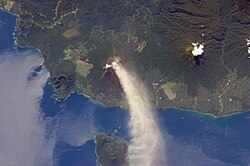



Lolobau Island is an island in the Bismarck Sea, within the West New Britain Province of the Islands Region, in northern Papua New Guinea.
Contents
During World War II a number military actions occurred near Lolobau Island including in early 1943. [1] For example, on May 3, 1943 B-24 Liberator of the United States 5th Air forces attacked shipping near the island. [2]
Lolobau Island is home to the Lolobau Volcano. [3] It is recorded as having erupted in the 20th century. [4]